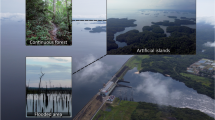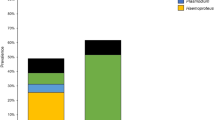Abstract
The study of local variations in abundance and lineage distribution within the same host species is essential in order to understand the virulence and the differences in risk of exposure between individuals. Several studies have investigated factors shaping the abundance and geographical distribution of avian malaria in different continents. However, the vast territories of Asia have received little attention. Moreover, the distribution of haemosporidians remains unknown in many families of birds, for example the Sittidae. Here, we present the first molecular-based study that investigates the infection of haemosporidians in different populations of a bird from Western Asia in order to determine geographical differences in the prevalence and diversity of parasite lineages. We explore the occurrence of haemosporidians infecting Krüpers’ Nuthatch Sitta krueperi in the Anatolian peninsula. Also, we analyse environmental factors predicting variation in parasite abundance. Our results revealed significant differences in abundance and parasite lineage distribution between northern and southern populations. Altitude of sampling sites was associated with the variability in the prevalence of haemosporidians. We also showed a higher diversity of Haemoproteus and Leucocytozoon lineages in southern populations. The majority of parasite lineages found had not previously been described.
Zusammenfassung
Geographische Variation Parasitischer Hämosporidien in Türkischen Populationen des Türkenkleibers Sitta krueperi
Eine Untersuchung lokaler Schwankungen in Abundanz und Verbreitung von Parasiten-Abstammungslinien innerhalb derselben Wirtsart ist unentbehrlich, um Virulenz und Unterschiede im Expositionsrisiko zwischen Individuen zu verstehen. Mehrere Studien haben Faktoren untersucht, welche die Abundanz und geographische Verbreitung von Vogelmalaria auf verschiedenen Kontinenten prägen. Den ausgedehnten Gebieten Asiens wurde jedoch wenig Beachtung geschenkt. Darüber hinaus ist die Verbreitung von Hämosporidien in vielen Vogelfamilien wie zum Beispiel den Kleibern (Sittidae) nach wie vor unbekannt. Hier stellen wir die erste molekulare Studie vor, welche die Infektion mit Hämosporidien in verschiedenen Populationen eines westasiatischen Vogels untersucht, um geographische Unterschiede in der Prävalenz und Diversität von Parasiten-Abstammungslinien zu ermitteln. Wir erforschen das Auftreten von Hämosporidien, die Türkenkleiber Sitta krueperi infizieren, in Kleinasien. Wir analysieren außerdem Umweltfaktoren, die Variation in der Parasitenabundanz vorhersagen. Unsere Ergebnisse zeigten signifikante Unterschiede in der Abundanz und Verbreitung von Parasiten-Abstammungslinien zwischen nördlichen und südlichen Populationen. Die Höhenlage der Probenahmegebiete stand mit der Variabilität in der Prävalenz von Hämosporidien in Zusammenhang. Wir zeigten auch eine höhere Diversität von Haemoproteus- und Leucocytozoon-Linien in südlichen Populationen. Der Großteil der gefundenen Parasiten-Abstammungslinien war bislang nicht beschrieben worden.


Similar content being viewed by others
References
Albayrak T, Gonzalez J, Drovetski SV, Wink M (2011) Phylogeography and population structure of Krüper’s Nuthatch Sitta krueperi from Turkey based on microsatellites and mitochondrial DNA. J Ornithol doi:https://doi.org/10.1007/s10336-011-0756 (online first)
Anderson RM, May RM (1978) Regulation and stability of host–parasite population interactions. I. Regulatory processes. J Anim Ecol 47:219–247
Belo NO, Pinheiro RT, Reis SE, Ricklefs RO, Braga EM (2011) Host species and parasite lineage diversity of haemosporidians in three different environments with distinct levels of disturbance. PLoS ONE 6(3):e17654. doi:https://doi.org/10.1371/journal.pone.0017654
Bensch S, Pérez-Tris J, Waldenström J, Hellgren O (2004) Linkage between nuclear and mitochondrial DNA sequences in avian malaria parasites multiple cases of cryptic speciation? Evolution 58:1617–1621
Bensch S, Hellgren O, Pérez-Tris J (2009) MalAvi: a public database of malaria parasites and related haemosporidians in avian hosts based on mitochondrial cytochrome b lineages. Mol Ecol Res 9:1353–1358
BirdLife International (2011) Species factsheet: Sitta krueperi. http://www.birdlife.org Accessed 19 October 2011
Chasar A, Loiseau C, Valkiūunas G, Iezhova TA, Smith TB, Sehgal RNM (2009) Prevalence and diversity patterns of avian blood parasites in degraded African rainforest habitats. Mol Ecol 18:4121–4133
Escalante AA, Freeland DE, Collins WE, Lal AA (1998) The evolution of primate malaria parasites based on the gene encoding cytochrome b from the linear mitochondrial genome. Proc Natl Acad Sci USA 95:8124–8129
Freed LA, Cann RL, Goff ML, Kuntz WA, Bodner GR (2005) Increase in avian malaria at upper elevation in Hawaii. Condor 107:753–764
Greiner EC, Bennett GF, White EM, Coombs RF (1975) Distribution of the avian hematozoa of North America. Can J Zool 53:1762–1787
Haldane JBS (1949) Disease and evolution. Ricerca Sci 19:68–76
Hall TA (1999) BioEdit: a user-friendly biological sequence alignment editor and analysis program for Windows 95/98/NT. Nucleic Acids Symp Ser 41:95–98
Hellgren O (2005) The occurrence of haemosporidian parasites in the Fennoscandian bluethroat (Luscinia svecica) population. J Ornithol 146:55–60
Hellgren O, Waldenstrom J, Bensch S (2004) A new PCR assay for simultaneous studies of Leucocytozoon, Plasmodium and Haemoproteus from avian blood. J Parasitol 90:797–802
Jakob EM, Marshall SD, Uetz GW (1996) Estimating fitness: a comparison of body condition indices. Oikos 77:61–67
Jenkins T, Owens IPF (2011) Biogeography of avian blood parasites (Leucocytozoon spp.) in two resident hosts across Europe: phylogeographic structuring or the abundance–occupancy relationship? Mol Ecol 20:3910–3920
Jovani R, Tella JL, Forero MG, Bertellotti M, Blanco G, Ceballos O, Donázar JA (2001) Apparent absence of blood parasites in the Patagonian seabird community: is it related to the marine environment? Waterbirds 24:430–433
Kimura M, Dhondt AA, Lovette IJ (2006) Phylogeographic structuring of Plasmodium lineages across the North American range of the house finch (Carpodacus mexicanus). J Parasitol 92:1043–1049
Knowles SCL, Wood MJ, Alves R, Wilson GJ, Bensch S, Sheldon BC (2011) Molecular epidemiology of malaria prevalence and parasitaemia in a wild bird population. Mol Ecol 20:1062–1076
LaPointe DA, Atkinson CT, Samuel MD (2012) Ecology and conservation biology of avian malaria. Ann NY Acad Sci. doi:https://doi.org/10.1111/j.1749-6632.2011.06431.x
Lima MR, Simpson L, Fecchio A, Kyaw C (2010) Low prevalence of haemosporidian parasites in the introduced house sparrow (Passer domesticus) in Brazil. Acta Parasitol 55:297–303
Loiseau C, Iezhova TA, Valkiūunas G, Chasar A, Hutchinson A, Buermann W, Smith TB, Sehgal RNM (2010) Spatial variation of haemosporidian parasite infection in African rainforest bird species. J Parasitol 96:21–29
Marzal A, Ricklefs RE, Valkiūnas G, Albayrak T, Arriero E, Bonneaud C, Czirják GA, Ewen J, Hellgren O, Hořáková D, Iezhova TA, Jensen H, Križanauskienė A, Lima MR, de Lope F, Magnussen E, Martin LB, Møller AP, Palinauskas V, Pap PL, Pérez-Tris J, Sehgal RN, Soler M, Szöllosi E, Westerdahl H, Zetindjiev P, Bensch S (2011) Diversity, loss, and gain of malaria parasites in a globally invasive bird. PLoS ONE 6(7):e21905. doi:https://doi.org/10.1371/journal.pone.0021905
Patz JA, Githeko AK, McCarty JP, Hussein S, Confalonieri U, de Wet N (2003) Climate change and infectious diseases. Chapter 6. In: McMichael AJ, Campbell-Lendrum DH, Corvalan CF, Ebi KL, Githeko A, Scheraga JD, Woodward A (eds) Climate change and human health: risks and responses. World Health Organization, Geneva, pp 103–132
Read AF, Taylor LH (2001) The ecology of genetically diverse infections. Science 292:1099–1102
Reed KD, Meece JK, Henkel JS, Shukla SK (2003) Birds, migration and emerging zoonoses: west Nile virus, Lyme disease, influenza A and enteropathogens. Clin Med Res 1:5–12
Ricklefs RE, Swanson B, Fallon SM, Martinez A, Scheuerlein A, Gray J, Latta SL (2005) Community relationships of avian malaria parasites in southern Missouri. Ecol Monogr 75:543–559
Santiago-Alarcon D, Whiteman NK, Parker PG, Ricklefs RE, Valkiunas G (2008) Patterns of parasite abundance and distribution in island populations of endemic Galápagos birds. J Parasitol 94:584–590
Schulte RD, Makus C, Hasert B, Michiels NK, Schulenburg H (2010) Multiple reciprocal adaptations and rapid genetic change upon experimental coevolution of an animal host and its microbial parasite. Proc Natl Acad Sci USA 107:7359–7364
Shurulinkov P, Chakarov N (2006) Prevalence of blood parasites in different local populations of reed warbler (Acrocephalus scirpaceus) and great reed warbler (Acrocephalus arundinaceus). Parasitol Res 99(5):588–592
Sol D, Jovani R, Torres J (2000) Geographical variation in blood parasites in feral pigeons: the role of vectors. Ecography 23:307–314
Svensson L (1992) Identification guide to European passerines. British Trust for Ornithology, Thetford
Szöllősi E, Cichoń M, Eens M, Hasselquist D, Kempenaers B, Merino S, Nilsson J-Å, Rosivall B, Rytkönen S, Török J, Wood MJ, Garamszegi LZ (2011) Determinants of distribution and prevalence of avian malaria in blue tit populations across Europe: separating host and parasite effects. J Evol Biol 24:2014–2024
Tamura K, Peterson D, Peterson N, Stecher G, Nei M, Kumar S (2011) MEGA5: molecular evolutionary genetics analysis using maximum likelihood, evolutionary distance, and maximum parsimony methods. Mol Biol Evol 28:2731–2739
Valkiūnas G (2005) Avian malaria parasites and other haemosporidia. CRC, Boca Raton
van Riper IIIC, van Riper SG, Goff ML, Laird M (1986) The epizootiology and ecological significance of malaria in Hawaiian land birds. Ecol Monogr 56:327–344
Acknowledgments
Metin Balçay kindly helped in the field work. We thank Indrikis Krams and an anonymous referee for their valuable comments on earlier versions of the manuscript. This study was funded by research projects of the Spanish Ministry of Education and Science (CGL2009-08976) and Junta of Extremadura (PRI08A116). All the experiments comply with the current laws of Turkey, where the experiments were performed.
Author information
Authors and Affiliations
Corresponding author
Additional information
Communicated by L. Fusani.
Rights and permissions
About this article
Cite this article
Marzal, A., Albayrak, T. Geographical variation of haemosporidian parasites in Turkish populations of Krüper’s Nuthatch Sitta krueperi. J Ornithol 153, 1225–1231 (2012). https://doi.org/10.1007/s10336-012-0853-z
Received:
Revised:
Accepted:
Published:
Issue Date:
DOI: https://doi.org/10.1007/s10336-012-0853-z




